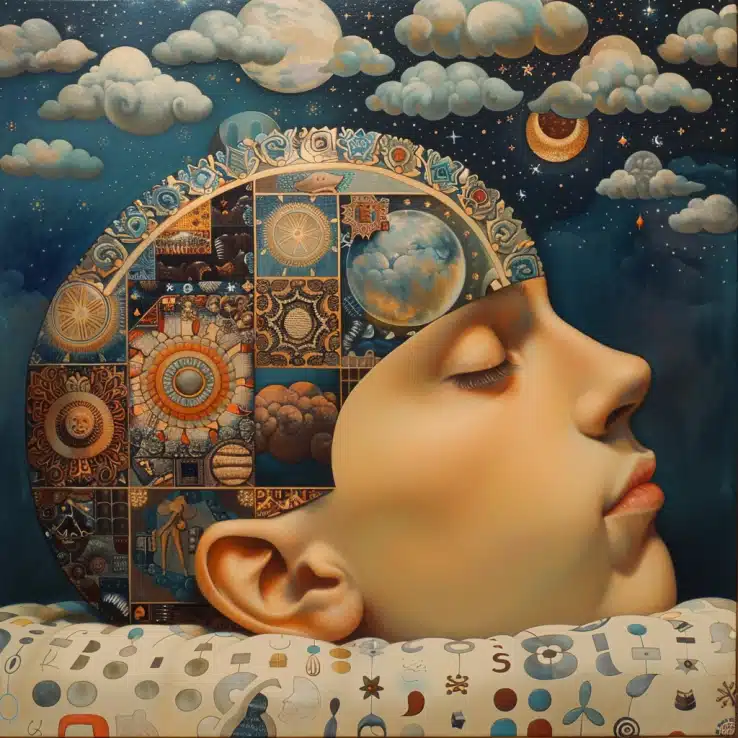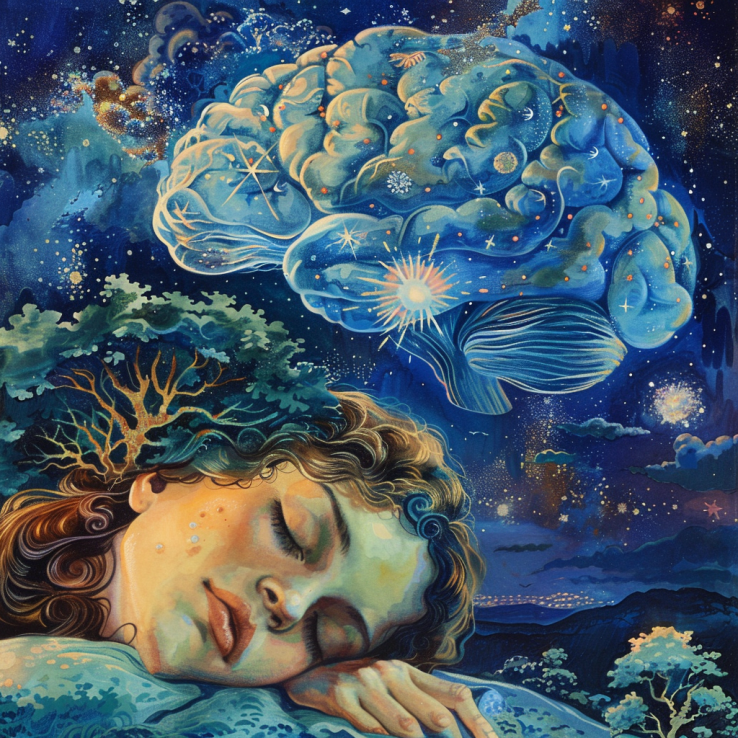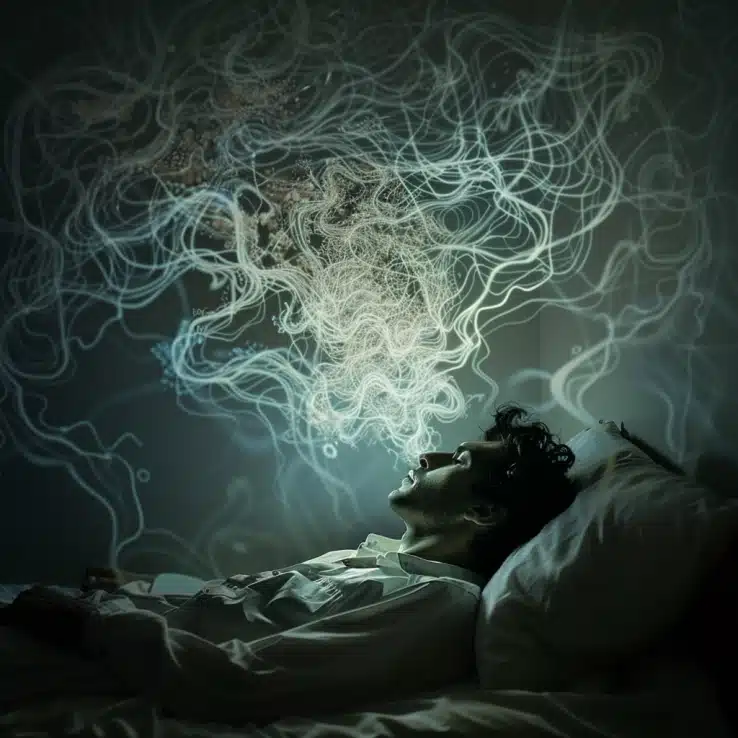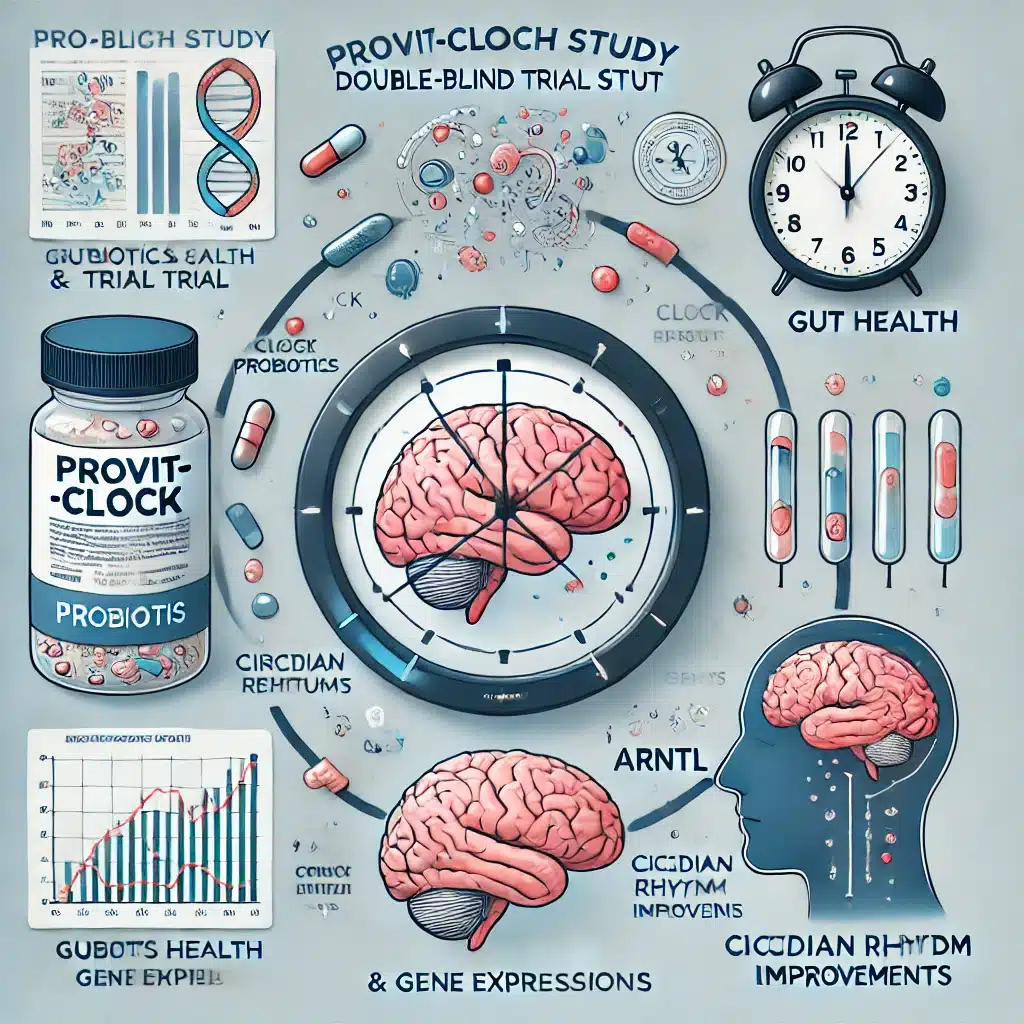Insomnia and daytime napping are causally associated with an increased risk of major depressive disorder (MDD), while sleep duration influences the risk of schizophrenia and attention-deficit/hyperactivity disorder (ADHD).
Highlights:
- Major Depressive Disorder (MDD): Insomnia and napping during the day significantly increase the risk of MDD.
- Schizophrenia: Longer sleep duration is associated with a higher risk of developing schizophrenia.
- Schizophrenia (suggestive): Daytime dozing and napping during the day show a suggestive association with an increased risk of schizophrenia.
- ADHD (suggestive): Longer sleep duration has a suggestive association with a decreased risk of ADHD.
- Genetic Link: The study used Mendelian randomization to minimize confounding factors, supporting the causal relationships between sleep parameters and psychiatric disorders.
Source: Frontiers in Genetics (2024)
Major Findings: Sleep vs. Psychiatric Disorder Risk (2024 Study)
Pei Chen et al. conducted a Mendelian randomization (MR) study to determine the potential causal impact of sleep on risk of developing various psychiatric disorders.
1. Insomnia & Major Depressive Disorder (MDD)
Finding: Insomnia significantly increases the risk of developing major depressive disorder (MDD).
Insomnia, which is characterized by trouble falling asleep or staying asleep, was found to double the risk of MDD.
This relationship is supported by genetic data, which suggests that chronic insomnia may lead to overactivity in brain regions responsible for mood regulation.
This overactivity can result in frequent mood swings and low mood, typical symptoms of depression.
Moreover, insomnia can reduce the brain’s sensitivity to serotonin, a neurotransmitter often linked to mood and depression.
Addressing insomnia may help in preventing or reducing the severity of MDD.
2. Napping During the Day & Major Depressive Disorder (MDD)
Finding: Napping during the day is significantly associated with an increased risk of MDD.
Daytime napping was found to increase the risk of MDD by about 80%.
This association may be due to the disruption of normal circadian rhythms, which affect hormone production and the body clock.
Excessive napping can reduce the quality of nighttime sleep, leading to a lack of energy and low mood during the day, symptoms commonly seen in depression.
Moderate napping might be beneficial, but too much can be detrimental to mental health.
3. Sleep Duration & Schizophrenia
Finding: Longer sleep duration is associated with an increased risk of schizophrenia.
People who sleep longer than average are at a higher risk of developing schizophrenia.
This may be due to disturbances in sleep structure and circadian rhythm, which are common in schizophrenia.
Sleep deprivation can increase dopamine release in the brain, exacerbating positive symptoms of schizophrenia such as hallucinations and delusions.
Additionally, a lack of slow-wave sleep, which is crucial for cognitive processing and emotional stability, can make individuals more susceptible to schizophrenia.
4. Daytime Dozing & Schizophrenia (Suggestive Association)
Finding: There is a suggestive association between daytime dozing and an increased risk of schizophrenia.
Daytime dozing, or the tendency to fall asleep unintentionally during the day, showed a potential link to a higher risk of schizophrenia.
Although not statistically significant, this association hints that frequent unplanned naps may disrupt the sleep-wake cycle, affecting mental health.
Further research is needed to confirm this link.
5. Napping During the Day & Schizophrenia (Suggestive Association)
Finding: Napping during the day shows a suggestive association with an increased risk of schizophrenia.
Similar to daytime dozing, regular daytime naps may also be linked to a higher risk of schizophrenia.
The disruption of normal sleep patterns and circadian rhythms might contribute to this risk.
While this association is not confirmed, it suggests that managing daytime sleep could be important for mental health.
6. Sleep Duration & Attention-Deficit/Hyperactivity Disorder (ADHD) (Suggestive Association)
Finding: Longer sleep duration has a suggestive association with a decreased risk of ADHD.
Longer sleep duration might be linked to a lower risk of ADHD, although this association is not statistically significant.
Adequate sleep is crucial for the development and organization of neural circuits in the brain.
Both insufficient and excessive sleep can disrupt neurotransmitter balance, particularly dopamine, which plays a key role in attention and behavior regulation.
Ensuring proper sleep might help in reducing the risk of ADHD.
(Related: Sleep Profiles of Different Psychiatric Disorders)
Study Details: Sleep Patterns & Psychiatric Disorder Risk (2024)

Sample
Genome-wide association study (GWAS) summary data for sleep parameters were obtained from:
- United Kingdom Biobank
- FinnGen Biobank
- European Bioinformatics Institute (EBI) databases
All individuals included in these studies were of European descent.
Methods
- Mendelian Randomization (MR): Used genetic variants as instrumental variables to infer causality between sleep parameters and psychiatric disorders.
- MR Analysis Tools: Included MR-Egger, weighted median, inverse-variance weighted (IVW), simple mode, weighted mode, maximum likelihood, penalized weighted median, and IVW (fixed effects).
- Statistical Analysis: Performed using R and the TwoSampleMR package. The primary method was IVW with multiplicative random effects. Sensitivity analyses included Cochran’s Q statistic for heterogeneity, MR-Egger for horizontal pleiotropy, and leave-one-out analysis.
Limitations
- Representation: The GWAS summary data were derived from populations of European descent, which may limit the generalizability of the findings to other ethnic groups.
- Genetic Instruments: The genetic variants used may not fully capture the complex nature of sleep parameters and psychiatric disorders.
- Pleiotropy: Despite using MR-Egger to assess pleiotropy, the potential for unrecognized pleiotropic effects remains.
- Assumptions: The study relies on MR assumptions such as the instrument’s exclusive effect through the exposure and the absence of unmeasured confounders, which, if violated, could bias the results.
- Specificity: Focused only on MDD, schizophrenia, and ADHD, leaving the causal relationship between sleep parameters and other psychiatric conditions unexplored.
How Sleep Patterns May Modulate Risk of Depression, Schizophrenia, ADHD (Possibilities)

1. Insomnia & Major Depressive Disorder (MDD)
- Neurotransmitter Imbalance: Insomnia can disrupt the balance of neurotransmitters in the brain, particularly serotonin, which plays a crucial role in mood regulation. Chronic insomnia may decrease serotonin receptor sensitivity and neurotransmission, leading to mood swings and depressive symptoms.
- Brain Activation Abnormalities: Persistent insomnia can cause overactivity in brain regions responsible for mood regulation, such as the amygdala and prefrontal cortex. This overactivity can result in increased emotional reactivity and a higher risk of depression.
- HPA Axis Dysregulation: Insomnia may lead to dysregulation of the hypothalamic-pituitary-adrenal (HPA) axis, increasing stress hormone (cortisol) levels, which are linked to depression.
- Inflammation: Chronic sleep disturbances are associated with increased levels of inflammatory markers, which have been implicated in the development of depression.
2. Napping During the Day & Major Depressive Disorder (MDD)
- Circadian Rhythm Disruption: Excessive daytime napping can disrupt normal circadian rhythms, affecting the body’s internal clock and hormone production. This disruption can lead to irregular sleep patterns and low mood.
- Reduced Nighttime Sleep Quality: Frequent daytime napping can interfere with the quality and duration of nighttime sleep, leading to sleep fragmentation and reduced restorative sleep, contributing to depressive symptoms.
- Energy & Mood Regulation: While moderate napping can restore energy, excessive napping might indicate underlying sleep problems or low energy levels, both of which are common in depression.
3. Sleep Duration & Schizophrenia
- Dopamine Regulation: Sleep deprivation or irregular sleep patterns can increase dopamine release in the brain. In individuals predisposed to schizophrenia, this can intensify positive symptoms like hallucinations and delusions.
- Circadian Rhythm & Sleep Structure: Disturbances in circadian rhythms and sleep architecture, particularly reductions in slow-wave sleep, can impair cognitive processes and emotional regulation, exacerbating schizophrenia symptoms.
- Cognitive Processing & Emotional Stability: Adequate sleep, especially deep sleep, is essential for cognitive processing and emotional stability. Insufficient deep sleep can increase vulnerability to schizophrenia by impairing these functions.
4. Daytime Dozing & Schizophrenia (Suggestive)
- Circadian Rhythm Disruption: Similar to daytime napping, unintentional dozing during the day can disrupt circadian rhythms, potentially leading to irregular sleep patterns and increasing the risk of schizophrenia.
- Cognitive & Emotional Effects: Frequent daytime dozing may indicate poor nighttime sleep quality, affecting cognitive and emotional stability and contributing to schizophrenia symptoms.
5. Napping During the Day & Schizophrenia (Suggestive)
- Sleep-Wake Cycle Disruption: Regular daytime naps can interfere with the natural sleep-wake cycle, leading to difficulties in maintaining consistent sleep patterns, which can affect mental health.
- Impaired Cognitive Functions: Daytime napping might reflect underlying sleep problems that impact cognitive functions critical for daily activities, potentially exacerbating schizophrenia symptoms.
6. Sleep Duration & ADHD (Suggestive)
- Neural Circuit Development: Proper sleep is vital for the development and organization of neural circuits in the brain. Both insufficient and excessive sleep can disrupt neurotransmitter balance, particularly dopamine, which regulates attention and behavior.
- Attention & Behavior Regulation: Adequate sleep is crucial for maintaining attention span, behavior control, and emotional stability. Disrupted sleep can lead to daytime fatigue, decreased attention, and increased impulsivity, all of which are characteristic of ADHD.
- Sleep Quality: The quality of sleep, not just its duration, impacts cognitive and behavioral functions. Poor sleep quality can lead to symptoms of ADHD by affecting focus, impulse control, and emotional regulation.
Correlation vs. Causality: Genetic Considerations

Despite the compelling findings, it’s crucial to acknowledge that the observed associations between sleep patterns and psychiatric disorders might still be correlations rather than true causal relationships.
1. Shared Genetic Factors (Pleiotropy)
The genetic variants used as instrumental variables in Mendelian randomization (MR) studies might influence multiple traits simultaneously.
For example, certain genes could affect both sleep patterns and psychiatric disorders independently, leading to a spurious correlation.
This phenomenon, known as pleiotropy, can complicate the interpretation of MR results, suggesting shared underlying genetic factors rather than a direct causal pathway.
2. Genetic Predisposition
Both sleep disturbances and psychiatric disorders might stem from a common genetic predisposition.
Individuals with specific genetic profiles may be more prone to both poor sleep and mental health issues, making it challenging to disentangle the direction of causality.
For instance, genes that affect neurotransmitter systems like serotonin and dopamine could simultaneously impact sleep regulation and mood disorders.
3. Confounding Variables
Even with advanced statistical techniques like MR, there might be unmeasured confounding variables that influence both sleep and psychiatric disorders.
Environmental factors, lifestyle choices, and other health conditions could play a significant role in shaping these associations, creating an apparent but non-causal link.
4. Bidirectional Relationship
The relationship between sleep and psychiatric disorders is likely bidirectional.
Poor sleep can exacerbate psychiatric symptoms, and psychiatric disorders can lead to sleep disturbances.
This reciprocal influence can make it challenging to determine the primary cause and effect, leading to potential misinterpretation of causal direction.
5. Methodological Limitations
Instrument Selection
The selection of genetic instruments in MR studies is based on their association with the exposure of interest (e.g., sleep patterns).
If these instruments are not perfectly specific to the exposure, they might capture genetic influences on other related traits, confounding the results.
Population Specificity
The genetic data used in the study predominantly come from populations of European descent.
This limitation affects the generalizability of the findings to other ethnic groups, who might have different genetic architectures and environmental interactions influencing both sleep and psychiatric disorders.
Conclusion: Link Between Sleep & Psychiatric Disorders
This study offers significant insights into the potential causal relationships between various sleep patterns and psychiatric disorders, highlighting the intricate interplay between sleep and mental health.
The findings suggest that insomnia and daytime napping are strongly associated with an increased risk of major depressive disorder, while longer sleep duration is linked to a higher risk of schizophrenia.
However, the associations might still be influenced by shared genetic factors and unmeasured confounders, indicating the need for cautious interpretation.
Despite these limitations, addressing sleep disturbances could provide a valuable avenue for preventing and managing psychiatric disorders, underscoring the importance of further research to explore these complex relationships in diverse populations.
References
- Study: The causal relationship between sleep and risk of psychiatric disorders: A two-sample mendelian randomization study (2024)
- Authors: Pei Chen et al.







